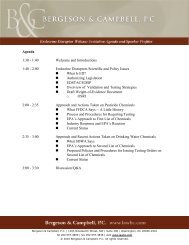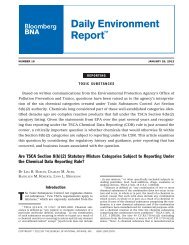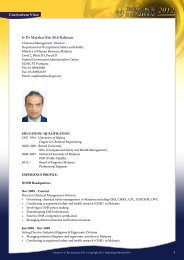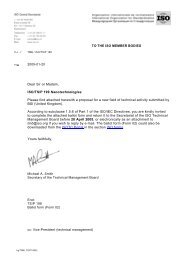TSCA Section 8(b)(2) Statutory Mixture - Bergeson & Campbell, P.C.
TSCA Section 8(b)(2) Statutory Mixture - Bergeson & Campbell, P.C.
TSCA Section 8(b)(2) Statutory Mixture - Bergeson & Campbell, P.C.
Create successful ePaper yourself
Turn your PDF publications into a flip-book with our unique Google optimized e-Paper software.
4<br />
action with respect to every chemical within the category.’’<br />
20<br />
When the House was considering H.R. 14032, the following<br />
was stated by Sen. Broyhill (R-NC):<br />
There is one thing that I would like to bring out in this colloquy.<br />
The gentleman from Nebraska has referred to the<br />
premarket notification section of the bill [Sec. 5] and indeed<br />
that is perhaps the most controversial portion. He did<br />
mention certain exemptions and perhaps one other thing<br />
needs pointing out. This is on page 163 with respect to the<br />
administrative authority in identifying a chemical substance.<br />
It states:<br />
[Sec. 8(b)] (2) To the extent consistent with the purposes<br />
of this Act the Administrator may, in lieu of listing, pursuant<br />
to paragraph (1), a chemical substance individually, list<br />
a category of chemical substances in which such substance<br />
is included.<br />
I may say to the gentleman, I think this is an extremely<br />
important leeway to the Administrator. Say for instance a<br />
chemical substance is manufactured and produced inhouse<br />
in an oil and chemical refinery. That chemical substance<br />
may be a catalyst that undergoes successive changes. Under<br />
these provisions we felt that instead of requiring a 90-<br />
day notice every time a change was made that had the result<br />
of changing the chemical constituency of the substance,<br />
the single category comment.<br />
I think that the gentleman will agree with me this is one<br />
of the provisions in which we carefully examined difficulties<br />
which could result from too rigid an act and met those<br />
possible objections. 21<br />
The Conference Report that accompanied the final<br />
bill, which included what is now <strong>Section</strong> 8(b)(2), does<br />
not address <strong>Section</strong> 8(b)(2):<br />
20 Legislative History at 468.<br />
21 Legislative History at 523 (excerpted from Congressional<br />
Record).<br />
Senate bill (section 8) . . . To determine which substances<br />
are new chemical substances for the purpose of the premarket<br />
notification provisions of section 5, subsection (b)<br />
requires the Administrator to publish an inventory of existing<br />
chemical substances or mixtures which any person<br />
report[s] to be commercially manufactured or processed<br />
within the United States under subsection (a) or under section<br />
5(a). The Administrator shall publish such list not later<br />
than 270 days after the date of enactment.<br />
...<br />
House amendment (section 8) . . . With respect to the inventory<br />
of existing chemical substances required by subsection<br />
(b), the House amendment provides that the inventory<br />
shall include at least each chemical substance which<br />
any person reports under section 5 or under section 8(a)<br />
was commercially manufactured or processed in the United<br />
States within 3 years before the effective date of the rules<br />
promulgated under section 8(a). The House amendment requires<br />
the publication of such inventory within 1 year after<br />
the effective date of the Act.<br />
...<br />
Conference substitute (section 8) . . . The conference substitute<br />
adopts, with some clarification, the House amendment<br />
in subsection (b) which requires the Administrator to<br />
compile, keep current, and publish an inventory of chemical<br />
substances and mixtures manufactured or processed in<br />
the United States. The conference committee compromised<br />
on the date that the Administrator shall first publish the inventory,<br />
which publication shall take place 315 days after<br />
the effective date of the Act. 22<br />
The Conference Report states that the House amendment<br />
includes a <strong>Section</strong> 26(c) provision similar to S.<br />
3149, and further states that the ‘‘conferees expect that<br />
the Administrator will find the authority to categorize<br />
especially helpful in promulgating rules under section<br />
5(a)(2) concerning what constitutes significant new use<br />
of chemical substances.’’ 23<br />
<strong>Section</strong> 8(b)(2) Regulatory History<br />
When EPA issued regulations implementing the initial<br />
<strong>TSCA</strong> Inventory over 30 years ago, EPA provided<br />
examples of the types of ‘‘mixtures’’ that were excluded<br />
from Inventory listing by ‘‘definition of section 8(b) of<br />
<strong>TSCA</strong>.’’ Specifically, in the December 1977 Federal<br />
Register notice establishing the <strong>TSCA</strong> Inventory reporting<br />
regulations, EPA stated:<br />
710.4 Scope of Inventory<br />
(c) Substances excluded by definition or section 8(b) of<br />
<strong>TSCA</strong>. The following substances are excluded from the inventory:<br />
. . . (2) Any mixture as defined in § 710.2(q);<br />
NOTE. - A chemical substance that is manufactured as part<br />
of a mixture is subject to these reporting regulations. This<br />
exclusion applies only to the mixture and not to the chemical<br />
substances of which the mixture is comprised. The term<br />
‘mixture’ includes alloys, inorganic glasses, ceramics, frits,<br />
and cements, including Portland cement. 24<br />
EPA also provided the following commentary:<br />
Comment 33: Manufacturers of alloys including steel,<br />
glasses, ceramics, enamels, Portland cement, and similar<br />
combinations of chemical substances should not be required<br />
to report for the inventory.<br />
Response: The Administrator agrees with this comment.<br />
Alloys, inorganic glasses, ceramics, frits, and cements, including<br />
Portland cement, are mixtures under <strong>TSCA</strong>; manufacturers<br />
of these products are not required to report them.<br />
However, as stated in a note at § 710.4(c), the exclusion of<br />
these products applies only to the mixture and not to the<br />
chemical substances of which the mixture is comprised.<br />
Thus, the metals in the case of alloys, or oxides in the case<br />
of glasses and ceramics, and any additives or components<br />
other than impurities, should be included on the inventory.<br />
The manufacturers of the metals, oxides, and additives<br />
would be responsible for reporting them. 25<br />
Subsequently, EPA published in 1978 various addenda<br />
to assist companies in determining Inventory status<br />
from its Candidate List of Chemical Substances. In<br />
Addendum III, EPA identified Class 2 substances (i.e., a<br />
chemical substance the composition of which cannot be<br />
represented by a definite chemical structural diagram)<br />
and provided a mechanism for identifying and reporting<br />
others. 26 In this addendum, EPA stated the following<br />
regarding <strong>Section</strong> 8(b)(2) category mixtures:<br />
22 Legislative History at 691-694.<br />
23 Legislative History at 715.<br />
24 42 Fed. Reg. at 64577.<br />
25 42 Fed. Reg. at 64585.<br />
26 EPA, Toxic Substances Control Act (<strong>TSCA</strong>) PL 94-469,<br />
Candidate List of Chemical Substances, Addendum III, Chemical<br />
Substances of Unknown or Variable Composition, Complex<br />
Reaction Products and Biological Materials (Mar. 1978)<br />
at 1 (Candidate List of Chemical Substances, Addendum III).<br />
4-12-12 COPYRIGHT 2012 BY THE BUREAU OF NATIONAL AFFAIRS, INC. TXLR ISSN 0887-7394







